Safe, clean and free of harmful substances?
Analytical methods for plastic packaging of foods
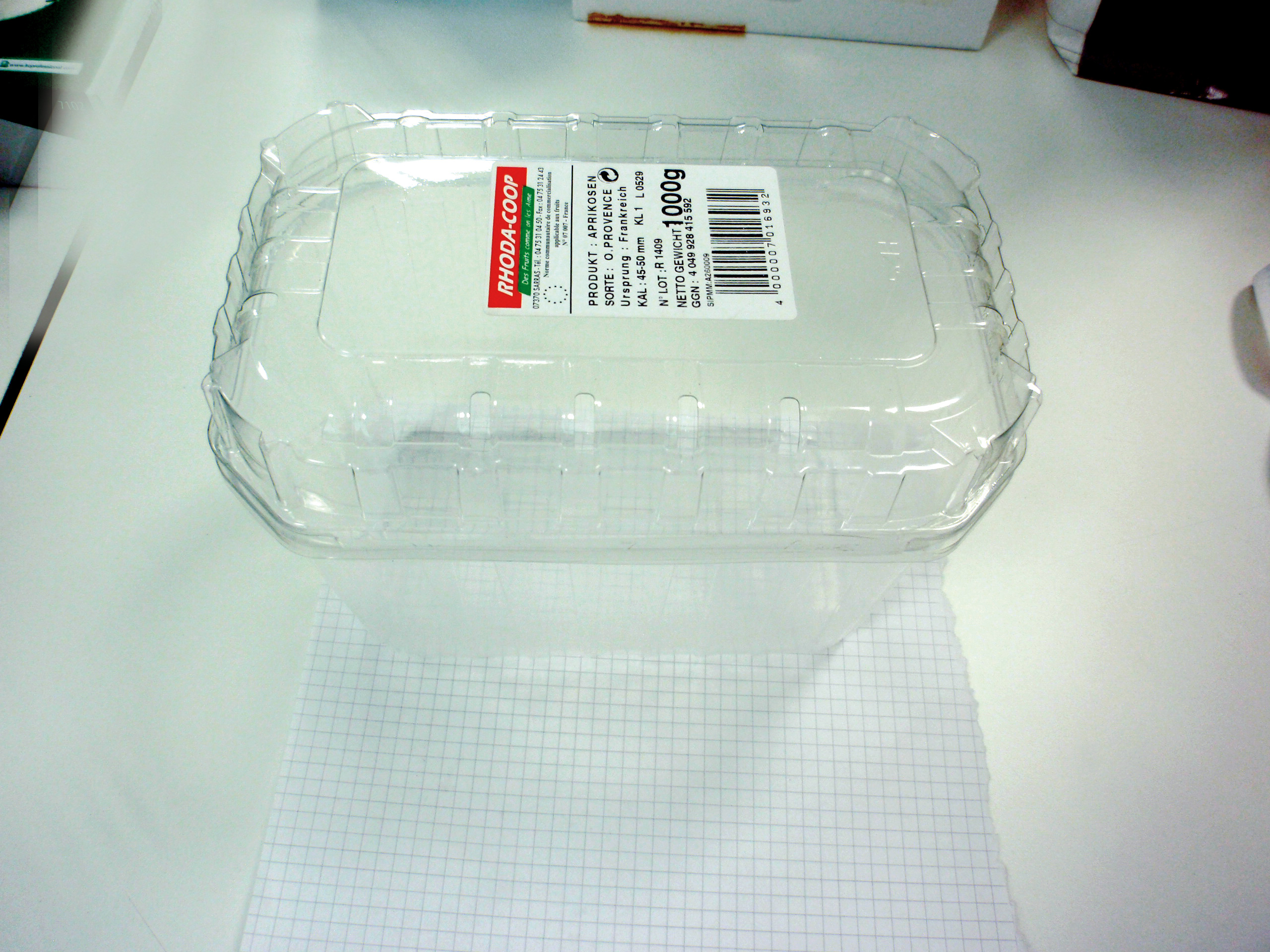
The influence of cups, plastic bottles and film packaging on human health and the environment is a challenge. Supermarket shelves are full of products that are, in part, packaged in highly complex plastics.
These types of packaging materials are lightweight and also highly stable, and protect expensive as well as easily perishable products against environmental influences. At the same time, plastic packaging carries colorful printed advertising messages and fact-oriented product information.
But plastic packaging materials are increasingly the subject of criticism, because undesirable and potentially hazardous substances can migrate from the packaging into the foods when in direct contact. More plastic also means more waste. Plastics not only end up in recycling yellow bags and on landfills but also in rivers and seas – and in the stomachs of fish and seabirds.
Just to quantify, a brief look at Germany as one of the largest European countries. In 2013, around 17.1 million tons of plastic packaging wastes were generated. The increase to this highest level is attributable mainly to changes in consumption patterns. Nearly 72 percent, i.e. 12 million tons of the packaging wastes went into recycling [1].
EU Ordinance on the Avoidance and Recovery of Packaging Wastes
As early as 1998, the European Union adopted the Ordinance on the Avoidance and Recovery of Packaging Wastes (VerpackV) and amended it in the most recent version of 2014 [2].
The objective of VerpackV is to avoid or reduce the environmental impacts of packaging waste. In addition, the share of beverages filled in reusable drinks packaging and environmental-friendly one-way drinks packaging should increase to at least 80 %.
According to a report of the European Environmental Agency (EEA) in 2013, Europeans recycled more waste from 2001 to 2010: the recycling share increased from 23 percent to 35 percent – in absolute numbers this was 63 million tons of household waste which found a new destination [3].
VerpackV and harmful substances
VerpackV also regulates the concentration of harmful substances such as heavy metals that may be present in packaging materials. Accordingly, packaging or its components may only enter circulation if the cumulative concentration of lead, cadmium, mercury and chromium VI does not exceed 100 mg/kg.
In addition to the REACH Ordinance Annex XVII, there is a ban on bringing certain cadmium-containing compounds into circulation if the cadmium content exceeds 100 mg/kg (0.01 % by mass). These restrictions are most important for plastic products as they are produced and distributed in high quantities.
In this case, a distinction is made between cadmium used for coloring certain substances and mixtures (e.g. cadmium sulfide or cadmium selenide) and cadmium used as a stabilizing agent (e.g. cadmium stearate) for certain mixtures or products of vinyl chloride polymers or copolymers. The addition of cadmium used as a dye is restricted in nearly all types of plastics, while the admixture of cadmium as a stabilizer pertains to 13 vinyl chloride (co)polymer product groups (i.e. PVC), for example packaging materials.
Recycled plastics for food packaging?
Particularly, recycled plastics as materials for food packaging are in focus, for instance PET bottles. The plastics experts group at the Federal Institute for Consumer Health Protection and Veterinary Medicine has explained this as follows:
The legal regulations for consumer goods are also applicable to recycled PET plastics. However, due to possible improper use and the generally non-homogeneous input material, additional quality assurance measures are required. The input material for the mechanical recycling process should consist of at least 99 % original ‘food grade’ PET. The recycling process applied must be able to remove migration-relevant substances from the polymer matrix that may be present due to prior use. The required cleaning efficiency is to be verified once in terms of a ‘worst-case’ scenario using model contaminants (surrogates) and using a migration test or evaluation. An adequate quality assurance analysis method is essential for monitoring of the production process [4].
Using spectroscopy, chromatography, mass spectrometry and materials testing technology, Shimadzu, as one of the world’s leading manufacturers of analytical instrumentation, offers the complete hardware and software range for reliable determination of hazardous substances and identification of the materials used.
Qualitative and quantitative determination of heavy metals
For rapid qualitative and quantitative determination of heavy metals in plastics (such as cadmium in the desired concentration range) used in food packaging, energy-dispersive X-ray fluorescence spectroscopic analysis is the method of choice. Shimadzu’s EDX series (EDX-7000P/8000P) enables the analysis of food packaging like plastic films, PET bottles, polystyrene yoghurt containers and much more, in the low-ppm range (figure 1). The sample can be positioned directly in the sample compartment without any complex sample preparation.
The sample to be examined is irradiated from below with high-energy X-rays. When these hit an atom, an electron from one of the lowest energy levels of the K and L shells is excited energetically to such an extent that it is ejected from its orbital position. The resulting ‘hole’ is immediately occupied by an electron falling from a higher shell. This process releases energy known as secondary energy or X-ray fluorescence energy.
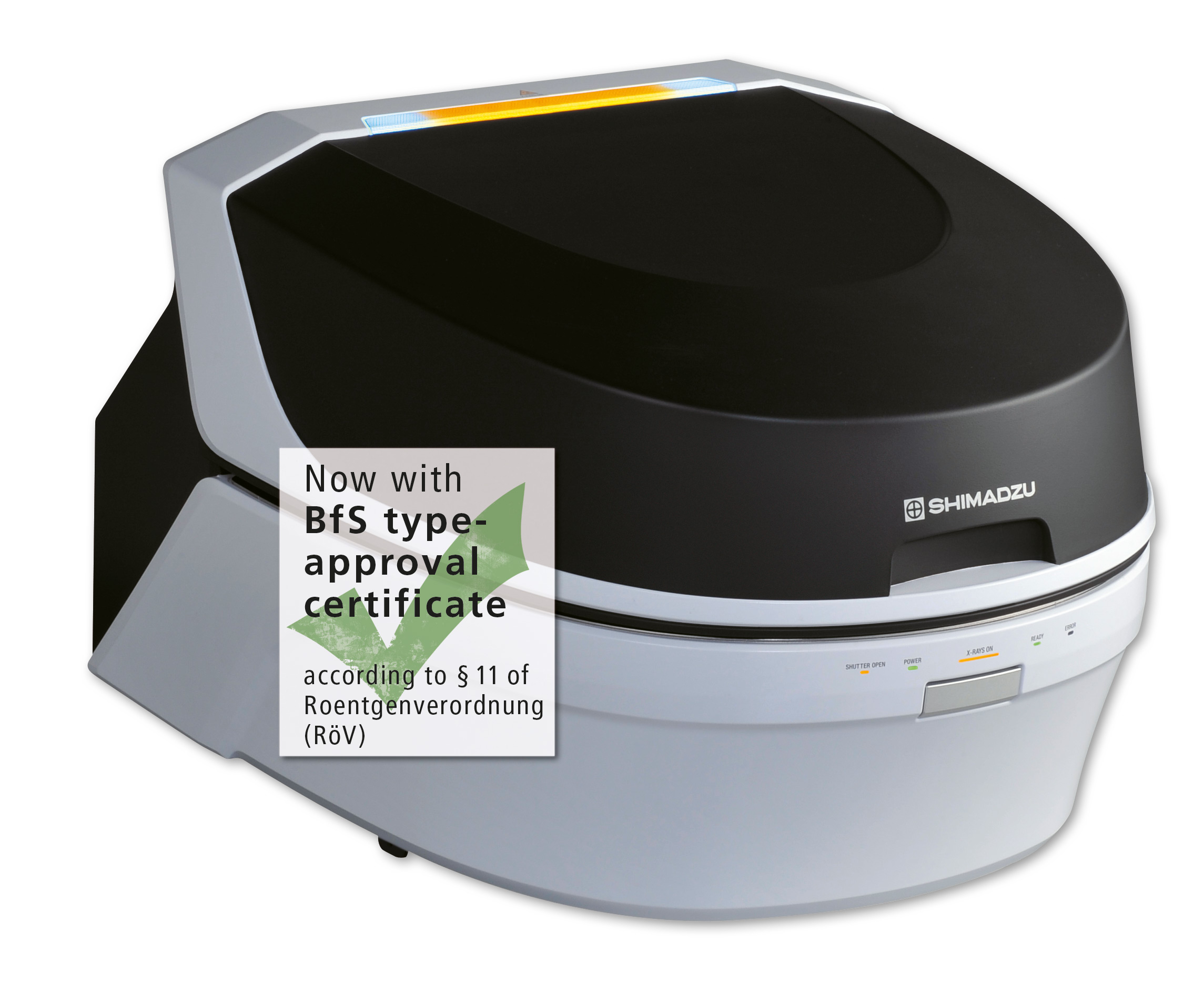 Figure 1: EDX-7000P/8000P
Figure 1: EDX-7000P/8000P
In the present example, this element-specific fluorescence radiation corresponds to the energy difference between the K or L shell and the shell of the higher energy levels from which the ‘falling’ electron originates. By knowing the energy ratios of the individual elements, reliable quantitative analysis of an unknown sample is possible: the detected X-ray fluorescence is element-specific.
Simultaneous determination of heavy metals
Simultaneous determination of heavy metals is carried out using ICP-OES spectrometers such as the ICPE-9820 (figure 3), which are characterized by high sensitivity, a wide dynamic measuring range and high sample throughput. The ICPE-9820 with CCD (charge coupled device) detector is equipped with vacuum optics, setting new standards with respect to performance, speed and operating costs.
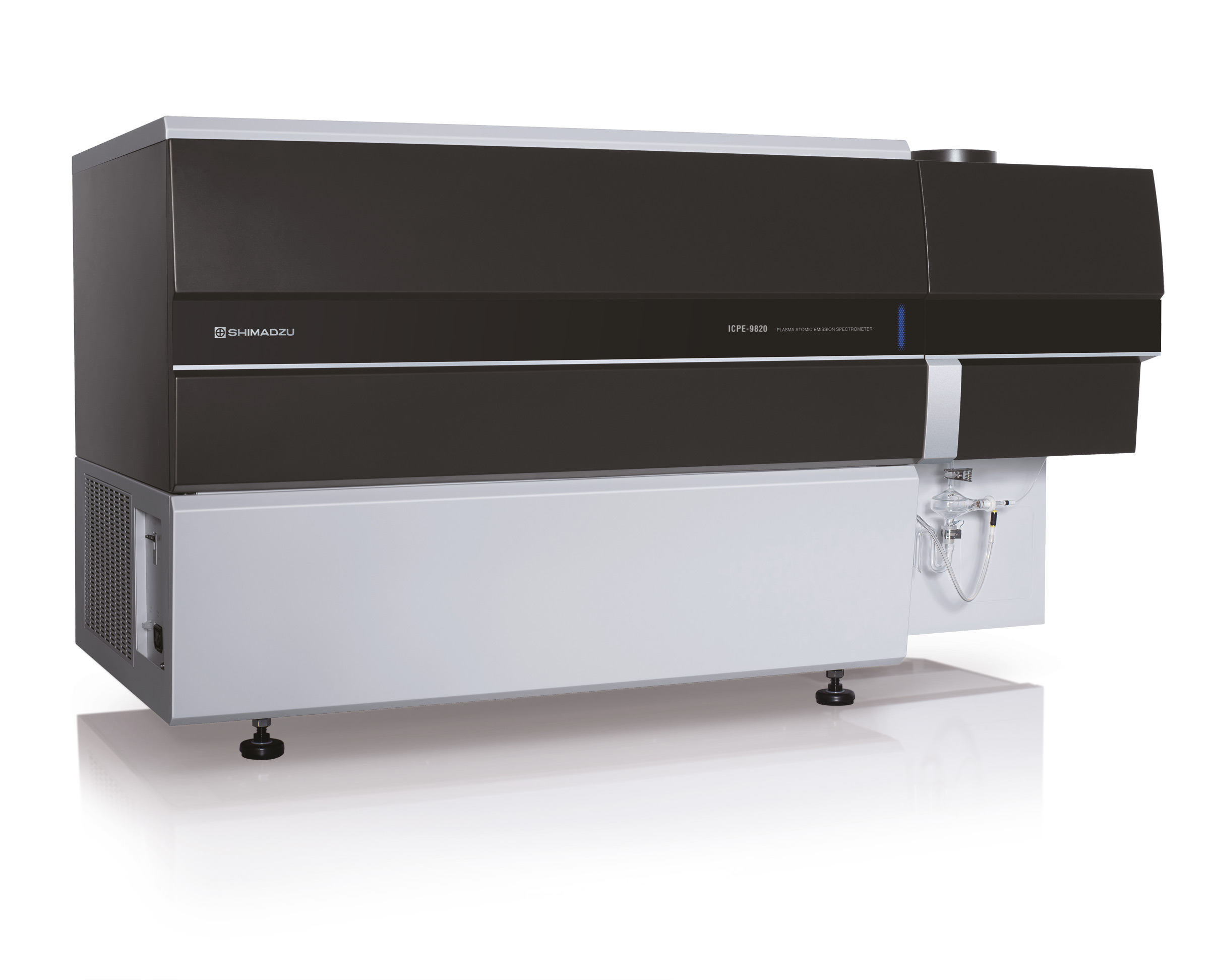 Figure 3: ICP-OES Spectrometer ICPE-9820
Figure 3: ICP-OES Spectrometer ICPE-9820
After applying a suitable digestion method the plastic samples are injected to the ICPE-9820. At argon plasma temperatures of appr. 10,000 K the atoms and ions are excited and subsequently moving back to ground state. At this step energy (light) is emitted in UV-VIS range.
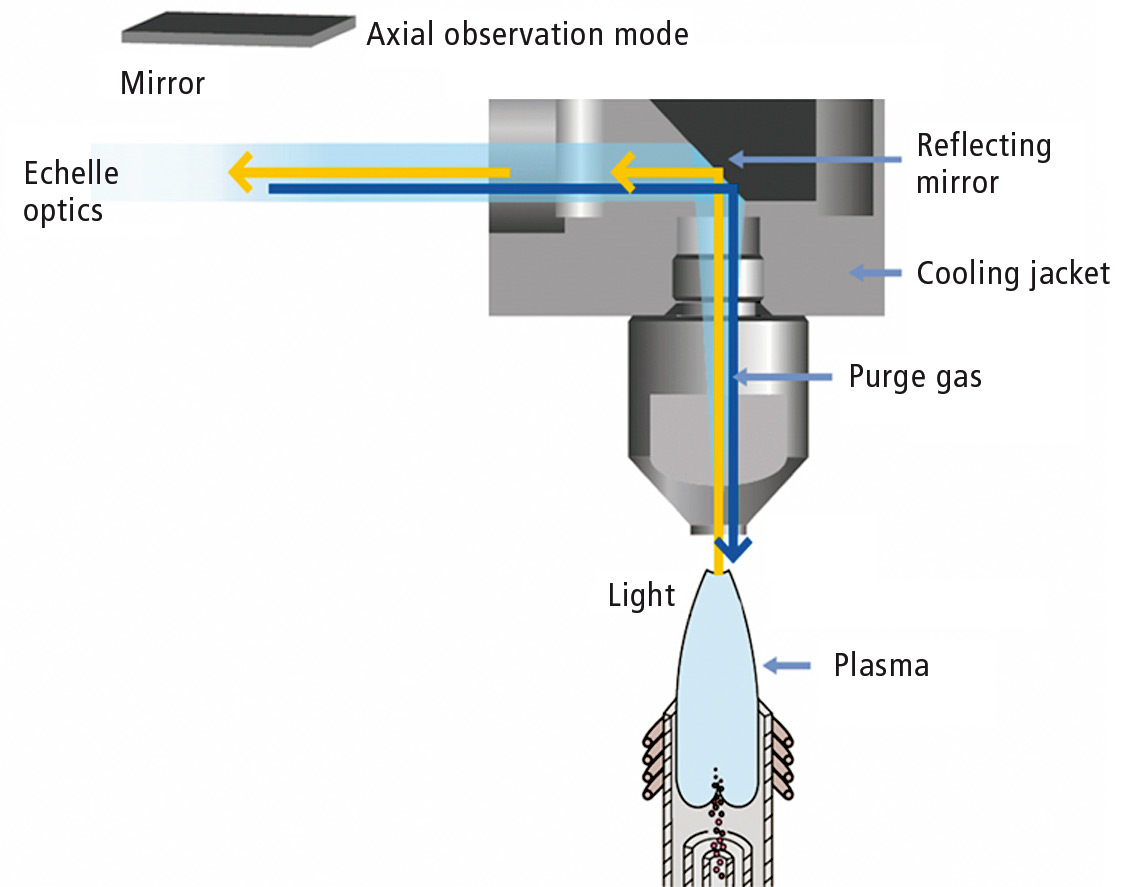
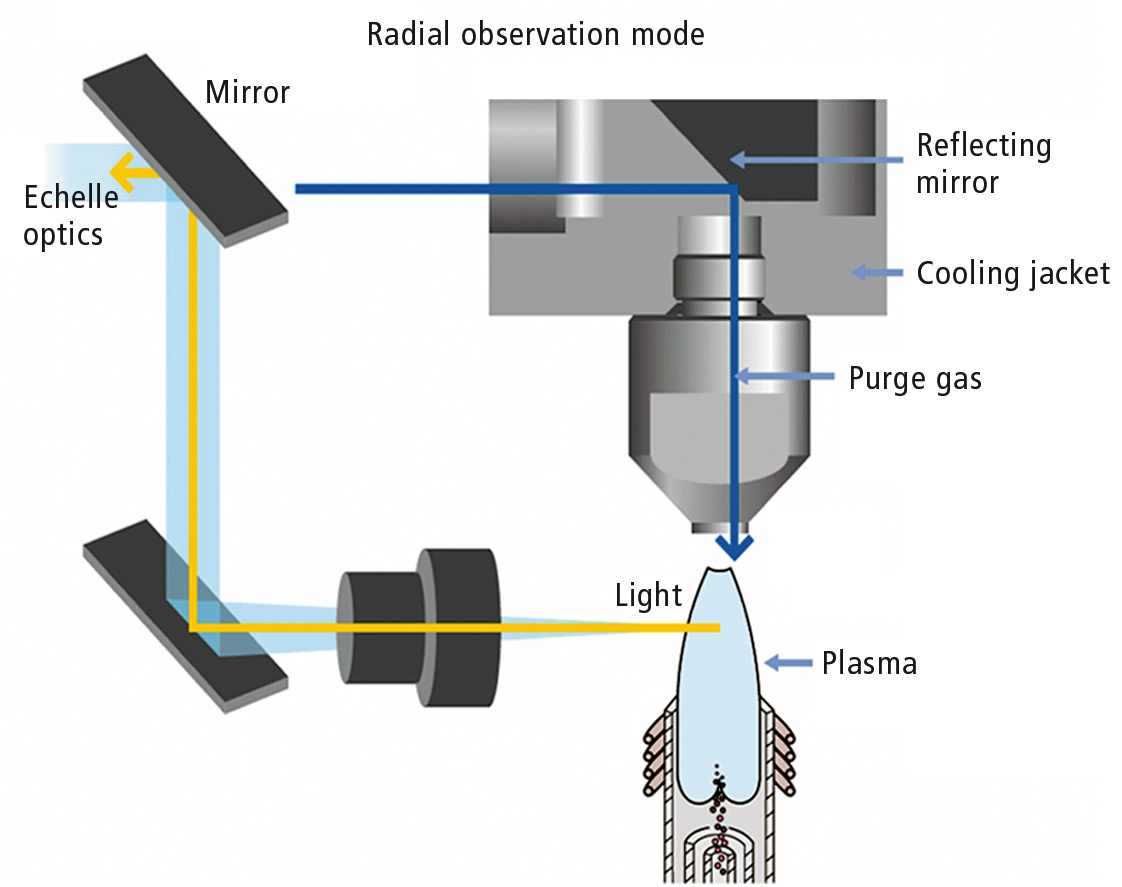 Figure 2: ICPE-9820 ICP-OES spectrometer with ‘dual view’ optics
Figure 2: ICPE-9820 ICP-OES spectrometer with ‘dual view’ optics
The radiation emitted is processed in the optical system and is measured by the CCD detector. The emission spectrum (detected in the range of 167 to 800 nm) contains information of over 70 elements, which can be used for quantification. This quantitative determination of elements is carried out using calibration curves from multi-element standards. Figure 2 shows the optical system of the ICPE-9820 in ‘dual view’ for axial and radial plasma observation.
Various sample preparation methods
Various methods are available for sample preparation. A widely used method is microwave digestion, carried out in microwave-permeable pressure vessels in a microwave oven. An example is the treatment of samples using a mixture of concentrated nitric acid with addition of a small amount of hydrogen peroxide at elevated pressure-temperature conditions. In addition, wet-ashing or dry-ashing, in which the organic constituents of a solid sample are digested via combustion in a crucible, are also possible.
The ICP-OES system configuration described here provides a current state of the art overview of the determination of heavy metals in plastic packaging according to the European Packaging Ordinance. The actual concentrations of the individual substances in the homogeneous sample material can vary considerably and can be analyzed easily and rapidly using the ICPE-9820 following sample preparation and dilution.
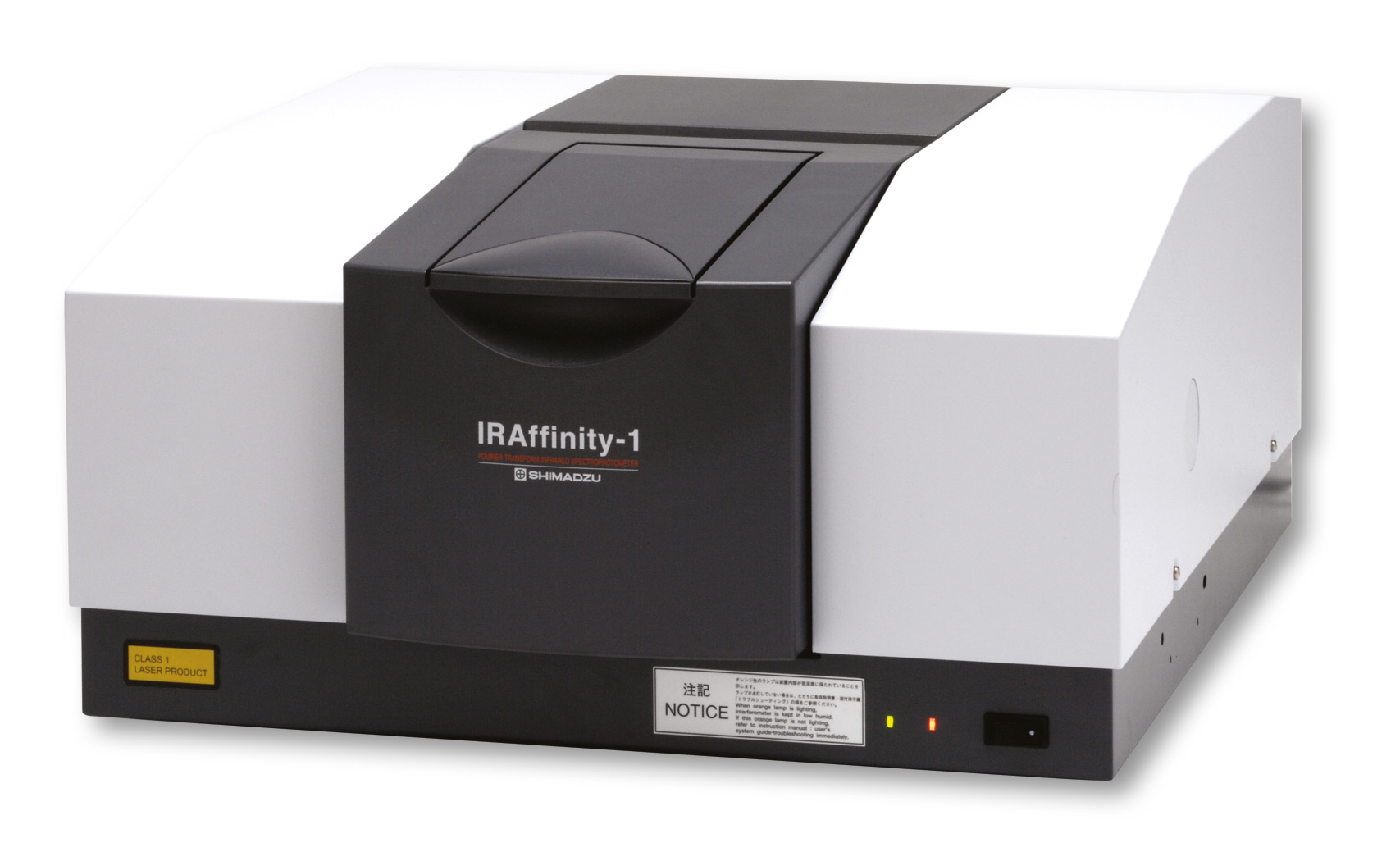 FTIR spectrometer IRAffinty-1S
FTIR spectrometer IRAffinty-1S
Identification of plastics, including main components and additives
FTIR spectroscopy using the IRAffinity-1S spectrophotometer in combination with ATR (attenuated total reflectance) technology offers an ideal system configuration for the identification of plastics. The determination of polymers takes place via diamond-ATR and enables unequivocal determination of the main components as well as the identification of additives, for instance plasticizers, as a function of the concentration.
PVC for instance is a very hard and brittle plastic in its initial form needing a plasticizer to make it more flexible. Soft PVC is used, for example, in the production of packaging films applied as outer packaging of PET beverage bottles. PVC films are also still used at deli counters.
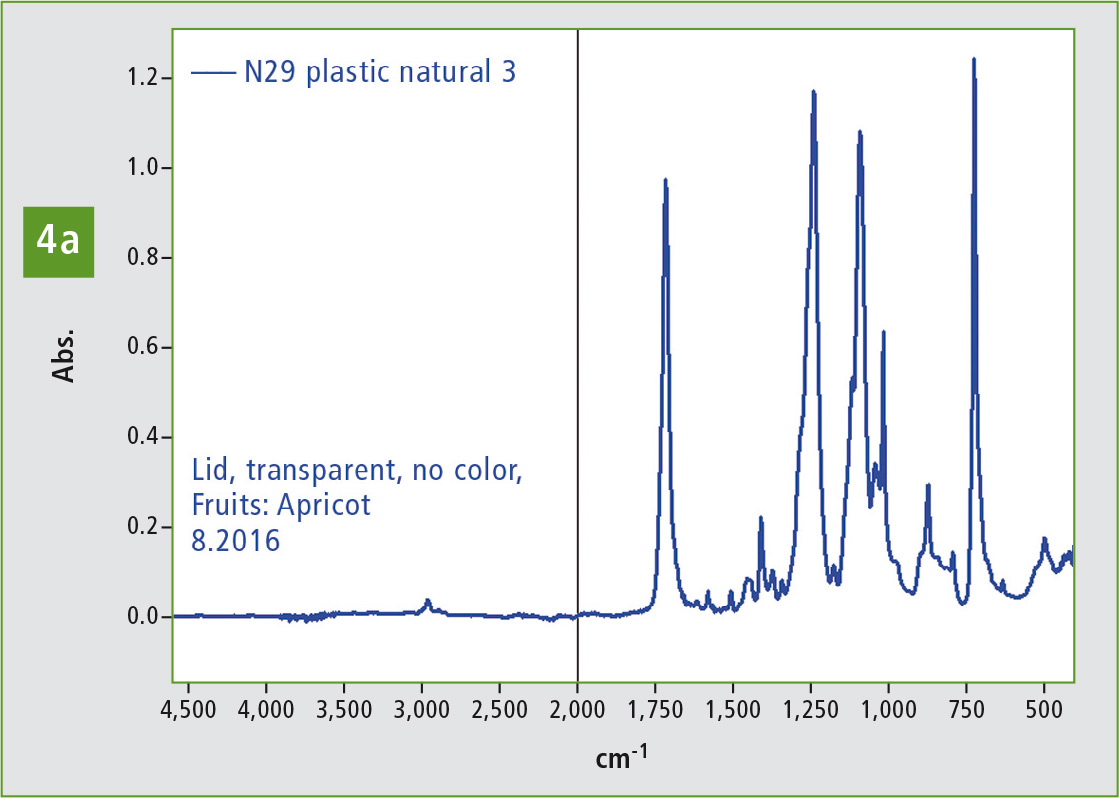
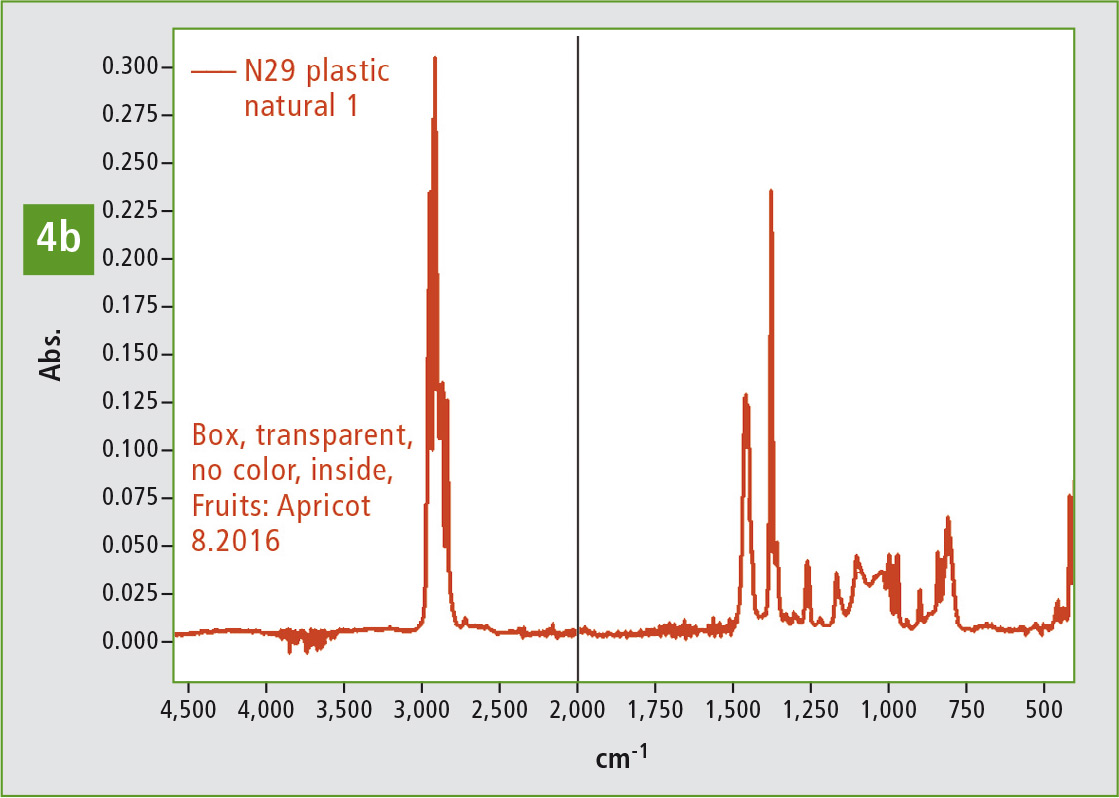 Figure 4: Shown here is the packaging for apricots – a plastic box with lid and a label ‘Recycling 5 for polypropylene’ under the box. The box is made of polypropylene (IR spectrum figure 4b), while the lid is made of PET (IR spectrum figure 4a).
Figure 4: Shown here is the packaging for apricots – a plastic box with lid and a label ‘Recycling 5 for polypropylene’ under the box. The box is made of polypropylene (IR spectrum figure 4b), while the lid is made of PET (IR spectrum figure 4a).
The use of the particularly harmful, endocrine disruptive plasticizer DEHP (a phthalate) has, however, been banned in packaging of fat-containing foods. Plasticizers used in food packaging materials pose a risk for migration of undesirable substances into the food. The food industry therefore uses other plastics such as polyethylene (PE), polypropylene (PP), polycarbonate (PC) and polyethylene terephthalate (PET).
The use of infrared spectroscopy
PE, PP, PC and PET were investigated via infrared spectroscopy in about 30 food packagings (table 1) obtained from supermarkets in the Netherlands and Germany. The packagings (transparent, colorless) were examined from the inside and outside. Where the packaging consisted of several components such as lids, bottle caps or film layers, for instance as tamponage for liquids, these components were included in the measurements. Consumer information on the label informing of the polymer used was also determined.
 Table 1: Distribution of the elements Pb, Cd, Hg and Cr in polyethylene (reference material BCR 681), *Detection limit at sample preparation with delution of 0.2g/20mL
Table 1: Distribution of the elements Pb, Cd, Hg and Cr in polyethylene (reference material BCR 681), *Detection limit at sample preparation with delution of 0.2g/20mL
It is always astonishing that a polymer may be listed on the outer packaging label as PP or PET – and found in the measurements – while the inner packaging actually consists of a PE. Will this not be a real challenge for the recycling industry?
Sample measurement using the FTIR spectrometer takes place non-destructively and without much time and effort. In particular, comparison of the IR spectrum of the actual measured sample with comprehensive spectral libraries allows the identification of the material. In addition, it is possible to obtain a clear indication of whether it is a pure substance, a product mixture or even a recyclate. In this investigation, only surfaces that could interact with an infrared penetration depth of up to 2 µm were considered.
Looking at the polymers identified in Table 2, those listed on the label and the packaged food, it can be concluded that each polymer is used ubiquitously. No trend could be found. In these types of packaging, the visual appearance, the value and ultimately the price determines the so-called ‘make-up.’ Among the polymers found, no PVC film could be identified.
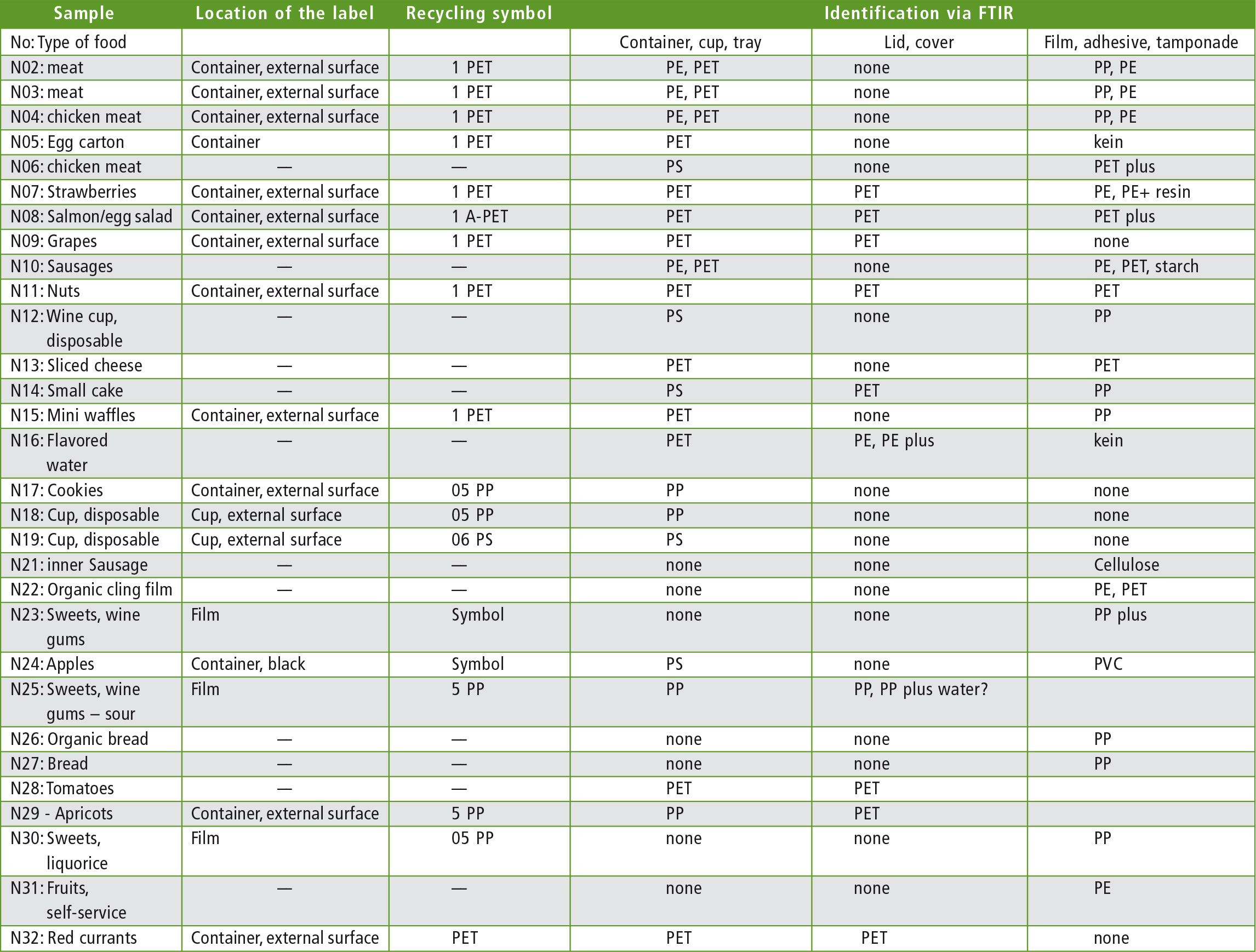 Table 2: Transparent, colorless packaging material and the infrared-identified main polymers found in the packaging
Table 2: Transparent, colorless packaging material and the infrared-identified main polymers found in the packaging
Summary
The determination of plastic food packaging requires careful quality assurance analysis using EDX, ICP-OES and FTIR spectrometry. Investigation of transparent packaging materials using FTIR-ATR technology, however, reveals that the plastics indicated on the recycling symbol are not always unequivocal. In some PET and PP samples, other plastics have been identified. Such mixtures place high demands on the recycling industry. Further investigations using complementary analysis methods on this topic should provide more information and lead to a complete solution – including colorless and dyed materials up to black plastics.
Literature
[1] Umweltbundesamt, Abfall- und Kreislaufwirtschaft – Verpackungsabfälle 2/2016
[2] Verordnung über die Vermeidung und Verwertung von Verpackungsabfällen (Verpackungsverordnung – VerpackV), 2014
[3] EEA Report, Managing municipal solid waste, ISSN 1725-9177, 2/2013
[4] Gesundheitliche Beurteilung von Kunststoffen im Lebensmittelverkehr: Stellungnahme der Kunststoffkommission des Bundesinstituts für gesundheitlichen Verbraucherschutz und Veterinärmedizin zur Verwendung von Kunststofferzeugnissen für Mehrweganwendungen und von Kunststoff-Recyclaten für die Herstellung von Lebensmittelbedarfsgegenständen, Bundesgesundheitsblatt, 1995, 38, 73